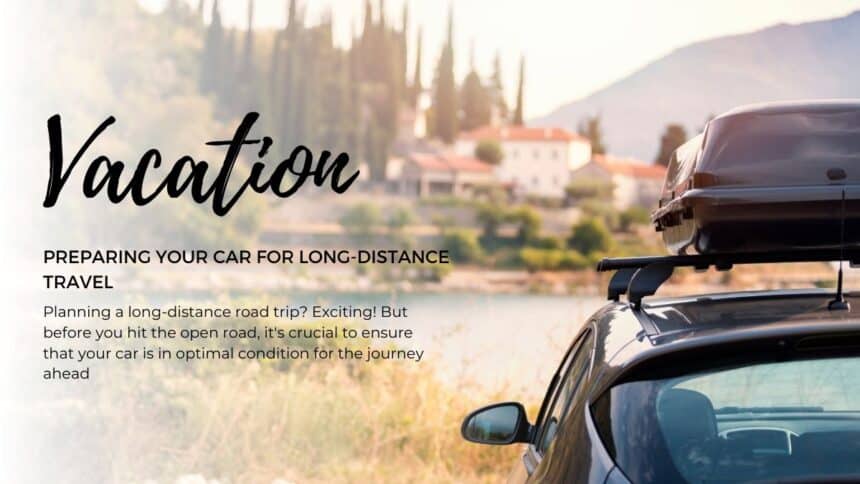Planning a long-distance road trip? Exciting! But before you hit the open road, it’s crucial to ensure that your car is in optimal condition for the journey ahead. In this comprehensive guide, we will walk you through the essential steps to prepare your car for long-distance travel. From checking fluid levels to inspecting tires, we’ve got you covered. So, buckle up and let’s dive into the nitty-gritty of getting your car ready for the adventure!
Preparing Your Car for Long-Distance Travel
Whether you’re embarking on a cross-country expedition or venturing into the unknown, taking the time to prepare your car can prevent unforeseen breakdowns and ensure a smooth journey. Here are some crucial steps to follow before you hit the road:
1. Inspect Your Tires: The Foundation of a Safe Journey
Your car’s tires are its only point of contact with the road, making them a vital aspect of road safety. Ensure that your tires are in excellent condition by:
- Checking Tread Depth: Measure the tread depth using a tread depth gauge or the penny test. The recommended minimum depth is 2/32 of an inch (1.6mm).
- Inspecting for Damage: Look for signs of cuts, bulges, or uneven wear. Any abnormalities should be addressed promptly.
- Checking Tire Pressure: Refer to your car’s manual or the sticker inside the driver’s side door for the recommended tire pressure. Underinflated or overinflated tires can affect handling and fuel efficiency.
2. Fluid Levels: Keep Your Car Hydrated
Maintaining proper fluid levels is essential for your car’s performance and longevity. Before setting off, check the following fluids:
- Engine Oil: Ensure the oil level is within the recommended range. If it’s due for a change, consider doing so before your trip.
- Coolant: Check the coolant level in the reservoir and top it up if needed. This will prevent the engine from overheating during long drives.
- Brake Fluid: Verify that the brake fluid level is adequate. Low brake fluid can affect braking performance, jeopardizing your safety.
- Transmission Fluid: If your car has an automatic transmission, ensure the fluid is at the correct level. Refer to your owner’s manual for instructions.
3. Battery Check: Powering Your Adventure
A dead battery can quickly turn your adventure into a nightmare. Take these steps to avoid such a situation:
- Inspecting Battery Terminals: Check for any corrosion on the battery terminals. If present, clean it with a mixture of baking soda and water.
- Testing Battery Voltage: Use a multimeter to measure the battery’s voltage. A healthy battery typically reads between 12.4 and 12.7 volts.
- Replacing Old Batteries: If your battery is more than three years old or showing signs of weakness, consider replacing it before your trip.
4. Lights and Signals: Visibility and Communication
Properly functioning lights and signals are essential for both your safety and communication with other drivers. Before you head out, ensure the following:
- Headlights: Check that both high beams and low beams are working correctly. Replace any burnt-out bulbs.
- Brake Lights: Have someone step on the brake pedal while you verify that the brake lights illuminate. Replace any faulty bulbs.
- Turn Signals: Test all turn signals to ensure they are functioning correctly. Promptly replace any burnt-out bulbs.
5. Wipers and Washer Fluid: Clear Vision, Rain or Shine
Don’t let rain or road grime obstruct your view. Take these steps to ensure optimum visibility:
- Wiper Blades: Inspect the condition of your wiper blades. If they are worn or streaking, it’s time to replace them.
- Washer Fluid: Fill the washer fluid reservoir with a high-quality washer fluid that aids in cleaning the windshield effectively.
6. Brakes: Stopping Safely
Your car’s braking system is a crucial safety component. Here’s what you need to do before embarking on a long-distance journey:
- Checking Brake Pads: Inspect the thickness of your brake pads. If they are worn close to the minimum thickness, have them replaced.
- Brake Rotors: Examine the brake rotors for any signs of damage or excessive wear. If necessary, have them resurfaced or replaced.
- Brake Pedal Feel: Ensure the brake pedal feels firm and doesn’t sink to the floor when pressed.
FAQs about Preparing Your Car for Long-Distance Travel
It is recommended to check your tire pressure at least once a month and before long trips.
No, it’s crucial to use the type of engine oil recommended by the manufacturer. Consult your owner’s manual or the manufacturer’s website for the right specifications.
Wiper blades typically need replacement every six to twelve months, or sooner if they show signs of deterioration.
Yes, regular brake inspections are essential as they can detect potential issues before they become major problems. It’s better to be safe than sorry!
Absolutely! It’s wise to have a roadside emergency kit, including items like a spare tire, jack, jumper cables, flashlight, and first aid kit.
If you experience a breakdown, move your vehicle to a safe location, turn on hazard lights, and contact roadside assistance or a local mechanic for help.
Conclusion
Taking the time to prepare your car for long-distance travel is a wise investment. By following the steps outlined in this guide, you can enhance your safety, prevent potential breakdowns, and ensure a more enjoyable journey. So, before you embark on your next adventure, give your car the care it deserves. Happy travels!







